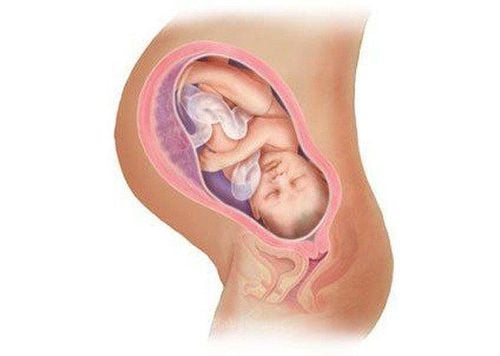This is an automatically translated article.
The article was professionally consulted by Specialist Doctor Obstetrician and Gynecologist - Department of Obstetrics and Gynecology - Vinmec Hai Phong International General Hospital. The doctor has many years of experience in the field of obstetrics and gynecology.
Labor does not always happen spontaneously, but requires the intervention and help of doctors. For a healthy and safe delivery, pregnant women should be aware of spontaneous contractions at 39 weeks of pregnancy.
1. What is labor induction?
Induction of labor is the process by which a doctor will use medication or other methods to induce labor.
2. Why is labor induction necessary?
Induction of labor is the stimulation of uterine contractions that enable a woman to give birth vaginally. Induction of labor is recommended when the health of both mother and baby is at risk.
In addition to some conditions that recommend labor induction for healthy women at 39 weeks of their first full-term pregnancy can be performed to induce labor to reduce the risk of a cesarean section.
Trắc nghiệm: Dấu hiệu cảnh báo chuyển dạ thực sự
Chuyển dạ là quá trình thai phụ bước vào giai đoạn “đẻ đau” để kết thúc thời gian “mang nặng”. Thời gian và dấu hiệu chuyển dạ sẽ khác nhau tùy vào vào từng người và nhiều yếu tố. Theo dõi bài trắc nghiệm dưới đây sẽ giúp bạn hiểu rõ hơn các dấu hiệu chuyển dạ một cách chính xác và an toàn.3. Indication for induction of labor at 39 . weeks
The doctor will prescribe the induction of labor at 39 weeks for pregnant women in the following cases:
This is the first full-term pregnancy Only one fetus Both mother and fetus are healthy.

4. Is it possible to induce labor before 39 weeks?
Induction of labor should not be performed when the mother and fetus are healthy and not in any danger. Because, babies born after 39 weeks usually have better health conditions than babies born before 39 weeks. Only in case the health of mother and baby occur risks, labor induction before 39 weeks will be perform.
Induction of labor at 39 weeks should be considered to reduce the risk of certain health problems. Healthy women who go into labor at 39 weeks typically have lower rates of preeclampsia and gestational hypertension than women who don't have labor onset at 39 weeks.
5. How is labor induction performed?
Here are some ways to induce labor:
Cervical ripening : The process of softening and thinning of the cervix in preparation for childbirth. Before labor, the doctor will use the Bishop index to assess the readiness of the cervix to induce labor. With this scoring system, a range from 0-13 is given to assess the condition of the cervix. If the Bishop index is lower than 6, it means that your cervix is not ready for labor. Amniocentesis: The doctor will sweep a gloved finger to separate the thin membrane that connects the amniotic sac to the uterine wall. This action causes your body to release natural prostaglandins, which help soften the cervix and can cause contractions. Oxytocin: A hormone that causes uterine contractions. It can be used to initiate labor or speed up labor. Contractions usually begin about 30 minutes after oxytocin is administered. Breaking the amniotic sac: To break the amniotic sac, your doctor will make a small hole in the amniotic sac with amniocentesis, which is done after giving you oxytocin. Amniocentesis is performed to initiate labor when the cervix is dilated and thinned and the baby's head has moved down into the pelvis. Most women go into labor within a few hours of their water breaking.

6. What are the risks of labor induction?
With some methods of induction of labor can cause the uterus to become overstimulated and lead to contractions too often. Too many contractions can lead to changes in the fetal heart rate. Other risks of cervical ripening and onset can cause infection in the mother and baby, uterine rupture, risk of cesarean delivery, and even fetal death.
7. Is labor induction effective?
Sometimes induction of labor fails and the woman must have another method of induction or a cesarean section. Women in labor should be given oxytocin for at least 12-18 hours after amniotomy.
8. Reasons to avoid caesarean section?
A cesarean section is a surgical procedure that allows the baby to be brought out of the mother's uterus without passing through the vagina like a normal birth. A cesarean section can pose certain risks, including:
Bleeding, infection, and damage to the intestines or bladder Longer recovery time compared to a vaginal birth C-section also increases the risks to the pregnancy followed by placental problems, uterine rupture, and hysterectomy. With the all-inclusive maternity care program at Vinmec International General Hospital, pregnant women will be directly monitored by Obstetricians and Gynecologists during the examination throughout pregnancy to the day of labor. With all abnormal symptoms or labor occurring near the due date, pregnant women can contact doctors and medical staff in the hospital system for timely diagnosis and intervention measures to help. Labor was safe and the baby was born healthy.
Please dial HOTLINE for more information or register for an appointment HERE. Download MyVinmec app to make appointments faster and to manage your bookings easily.
Articles refer to Acog.org source













